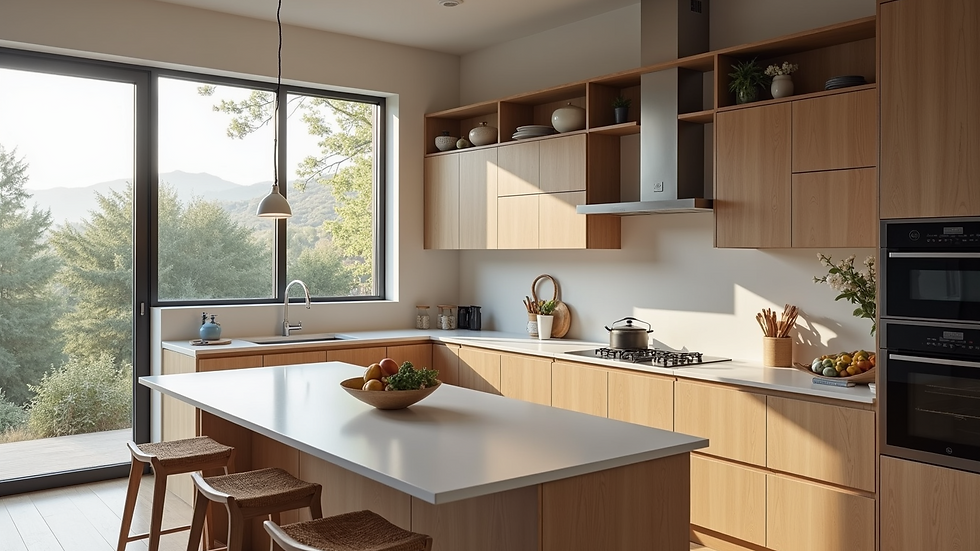Exploring Modern Trends in Architectural and Home Solutions
- Aug 19
- 4 min read
In recent years, the world of architecture and home design has undergone significant transformations. These changes reflect evolving lifestyles, technological advancements, and a growing emphasis on sustainability. Modern architectural trends are not only about aesthetics but also about creating functional, eco-friendly, and innovative living spaces. This article delves into the latest architectural trends and home solutions that are shaping the future of living environments.
Embracing Sustainable and Eco-Friendly Architectural Trends
Sustainability has become a cornerstone of modern architecture. Homeowners and designers alike are prioritising eco-friendly materials and energy-efficient designs to reduce environmental impact. Some of the most popular sustainable trends include:
Use of Recycled and Natural Materials: Bamboo, reclaimed wood, and recycled metal are increasingly used in construction and interior finishes.
Green Roofs and Walls: These features improve insulation, reduce urban heat, and enhance air quality.
Solar Panels and Energy Storage: Integrating renewable energy sources into home designs helps reduce reliance on fossil fuels.
Passive Design Principles: Orienting buildings to maximise natural light and ventilation reduces the need for artificial heating and cooling.
For example, a modern home might feature large south-facing windows to capture sunlight during winter, combined with overhangs that provide shade in summer. This passive solar design reduces energy consumption and enhances comfort.

Key Architectural Trends Influencing Home Solutions Today
The architectural landscape is evolving with new trends that blend technology, comfort, and style. Here are some of the most influential trends currently shaping home solutions:
Minimalist and Open-Plan Living
Minimalism continues to dominate, with open-plan layouts that create spacious, airy interiors. This trend favours clean lines, uncluttered spaces, and multifunctional furniture. Open-plan designs encourage social interaction and flexibility, making homes feel larger and more connected.
Smart Home Integration
Technology is seamlessly integrated into modern homes. Smart lighting, heating, security systems, and appliances can be controlled remotely, enhancing convenience and energy efficiency. Voice-activated assistants and automated systems are becoming standard features.
Biophilic Design
Bringing nature indoors is a growing trend. Biophilic design incorporates natural elements such as plants, water features, and natural light to improve wellbeing. This approach creates calming environments that connect occupants with the outdoors.
Adaptive Reuse and Modular Construction
Repurposing existing buildings and using modular construction techniques are gaining popularity. These methods reduce waste, speed up construction, and offer cost-effective solutions without compromising design quality.

What are the regular design services of an architect?
Architects provide a range of design services that guide a project from concept to completion. These services typically include:
Initial Consultation and Feasibility Study
Understanding client needs, site conditions, and budget constraints.
Conceptual Design
Creating preliminary sketches and 3D models to visualise ideas.
Design Development
Refining the design with detailed plans, elevations, and material selections.
Planning and Building Regulations Approval
Preparing documentation to obtain necessary permits and ensure compliance.
Construction Documentation
Producing detailed drawings and specifications for contractors.
Tendering and Contractor Selection
Assisting clients in choosing suitable builders through competitive bidding.
Construction Administration
Overseeing the construction process to ensure design intent and quality standards are met.
Post-Construction Services
Conducting inspections and addressing any issues after project completion.
These services ensure that every aspect of a building project is carefully planned and executed, resulting in a successful and satisfying outcome.
Innovative Home Solutions for Modern Living
Modern homes are designed to meet the demands of contemporary lifestyles. Here are some innovative solutions that enhance comfort, functionality, and style:
Flexible Spaces: Rooms that can serve multiple purposes, such as home offices that convert into guest bedrooms.
Indoor-Outdoor Living: Sliding glass walls and patios that blur the boundaries between inside and outside.
Energy-Efficient Appliances: Smart refrigerators, washers, and HVAC systems that reduce utility bills.
Water Conservation Systems: Rainwater harvesting and greywater recycling for sustainable water use.
Custom Storage Solutions: Built-in cabinetry and hidden storage to maximise space and reduce clutter.
Incorporating these solutions requires careful planning and often benefits from professional architectural design services to ensure seamless integration.

Future Directions in Architecture and Home Design
Looking ahead, architectural trends will continue to evolve with advances in technology and changing societal needs. Some future directions include:
3D Printing in Construction: Allowing rapid, cost-effective building with complex designs.
Net-Zero Energy Buildings: Homes that produce as much energy as they consume.
Augmented Reality (AR) and Virtual Reality (VR): Enhancing design visualisation and client engagement.
Health-Focused Design: Incorporating air purification, natural light, and ergonomic features to promote wellbeing.
Community-Centric Developments: Designing neighbourhoods that foster social interaction and shared amenities.
Staying informed about these trends can help homeowners and designers create spaces that are not only beautiful but also resilient and future-proof.
Exploring modern architectural trends reveals a dynamic field focused on sustainability, technology, and human-centred design. Whether you are planning a new build or renovating an existing home, understanding these trends and solutions can inspire smarter, more efficient, and aesthetically pleasing choices. Engaging with professional architectural design services can further ensure that your vision is realised with expertise and innovation.





Comments